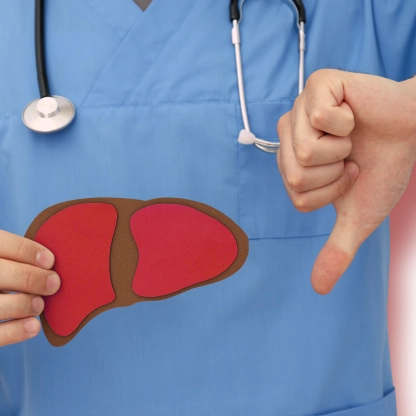
Article summary
Topic
Alcohol is a psychoactive substance known to humans for centuries. Its consumption is a significant element of social life, but unfortunately has a very negative effect on our health. It is estimated that in Poland 4 million persons drink alcohol in a risky and harmful manner. The scale of alcoholism is constantly increasing. There are about 860,000 alcohol addicts in Poland.1 As the organ that metabolises alcohol in 90%, the liver is at the greatest risk of negative effects of its consumption.2
Alcohol remains a serious problem causing significant damage to this organ
What is the cause of alcoholic liver disease?
The main cause of the development of alcoholic liver disease is excessive alcohol consumption. It leads to structural abnormalities of hepatic parenchyma and liver dysfunction. 2 Drinking more than 80 g of ethanol daily (equivalent to 2 litres of beer, 1 litre of wine or 5–6 cocktail glasses) significantly increases the risk of alcoholic liver disease.3
Symptoms of alcoholic fatty liver disease 2
Alcoholic fatty liver disease is mostly asymptomatic. Sometimes the patients report rather unspecific symptoms such as:
weakness
fatigue
lack of appetite
Symptoms of alcoholic hepatitis and cirrhosis2
The following symptoms may occur in the case of more advanced changes in liver structure and function caused by alcohol consumption:
- nausea,
- vomiting,
- abdominal pain,
- fever,
- skin changes.
Alcoholic cirrhosis is manifested as oedema, ascites, weight loss, jaundice and fever.
Accelerate liver regeneration with Phospholipids (Essentiale® Forte P)
How is alcoholic liver disease diagnosed?3
Confirmation of alcohol abuse by the patient is of key importance in the diagnosis of alcoholic liver disease. Furthermore, the doctor takes into account the characteristic clinical presentation and laboratory test results:
- AUDIT (Alcohol Use Disorder Identification Test) – it is a simple and effective screening testing method that helps determine the probability of alcohol problems,
- blood tests – liver enzyme levels,
- imaging examination of the liver – ultrasound scan.
How is alcoholic liver disease treated?2
At each stage of alcoholic liver disease, the essential element of treatment is complete alcohol abstinence, i.e. abstaining from drinking any amounts of alcohol, no matter how small. Other treatment methods are:
How to prevent alcoholic liver disease?3
To prevent alcoholic liver diseases, you should restrict alcohol consumption and care about healthy nutrition, in accordance with the principles of well-balanced diet.
FAQ
- fatty liver disease to the first stage of liver injury, which develops in 90% of persons consume excessive quantities of alcohol.3 It may develop even within 3-7 days after heavy alcohol abuse.2
- hepatitis is characterised by more extensive fattening and inflammation, which seriously damage liver cells – hepatocytes. In the case of mild or moderate hepatitis, alcohol abstinence leads to a reversal of most of the changes.3
- cirrhosis is the most advanced stage of alcoholic liver disease. There are 3 overlapping phenomena in the cirrhotic liver: injury to hepatic cells and processes of their repair as well as fibrosis of hepatic tissue. Alcoholic cirrhosis may be an indication for liver transplantation.2
In the case of alcoholic fatty liver disease as well as mild and moderate hepatitis, cessation of alcohol use may stop the development of the disease and even make the remaining changes reverse.2,3
In the case of severe hepatitis and cirrhosis, especially in persons who continue to drink alcohol, the prognosis is unfavourable and liver transplantation may prove necessary.3
- Dziukiewicz J. Alkoholizm i nadużywanie alkoholu: powszechny problem społeczny i zdrowotny XXI wieku; “Problemy nauk społecznych, humanistycznych, ekonomicznych: konteksty i wyzwania” (pp. 17-26). Wrocław 2017 https://rebus.us.edu.pl/bitstream/20.500.12128/7696/1/Dziukiewicz_Alkoholizm_i_naduzywanie_alkoholu.pdf accessed on: 15/05/2021
- Szymańska M. et al. Alkoholowa choroba wątroby w praktyce lekarskiej; Medycyna Ogólna i Nauki o Zdrowiu, 2011, Vol. 17, No. 3, 148-154 http://www.monz.pl/Alkoholowa-choroba-watroby-w-praktyce-lekarskiej,73251,0,2.html accessed on: 15/05/2021
- Mach T. Alkoholowe choroby wątroby. http://gastrologia.mp.pl/choroby/watroba/50966,alkoholowe-choroby-watroby. Accessed on: 31/07/2017.
%20(1)%20(1).webp)

